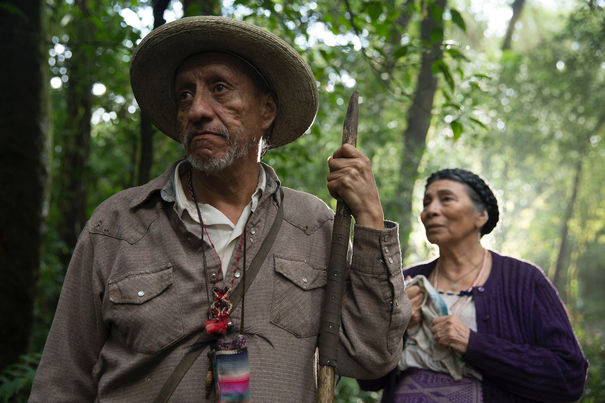A Cloak of Magic and Mysticism: SUEÑO EN OTRO IDIOMA
By Karly Gaitán Morales

Still from SUEÑO EN OTRO IDIOMA
Like a lyrical dream, the Mexican rainforest opens as a backdrop in filmmaker Ernesto Concretas’ SUEÑO EN OTRO IDIOMA. Not surprisingly, this film won the Audience Award in the World Cinema Dramatic category during this year’s Sundance Film Festival. The oneiric images, the sound work and the photography fully immerse the viewer in the narrative that unfolds in those two hours. The audience’s enraptured reception can be seen in their reactions: total silence in the room during dramatic moments and ovations or laughter when the director breaks the narrative thread with counterpoints and changes in emotional states, taking us by the hand from laughter to tears and from contemplation to amazement.
This is a story in which the indigenous language Zukril and the indigenous territory function as protagonists. The main characters, Isauro and Evaristo, are only complements that reinforce what the director wants to show us: the rescue of an ancient language that is about to go extinct after its last two elderly speakers, who have not passed it on to their descendants, are unable to practice it due to a fifty-year old breakup in a relationship that has become distant and silent.
A cloak of magic and mysticism bathes the ambience of the film. The light, the sound of rain, the decoration of the houses and the authentic costumes as well as the phonetics of the language all contribute towards the composition and approach to reality. All of these goals are achieved. However, there are some weaknesses in the continuity of the film. The narrative curve rises like an ellipsis on a Cartesian plane for almost forty minutes but, like a falling curtain, the element of humour breaks the theatrical expression since it represents a twist, a shift in the narrative technique, which may be the director’s attempt to stretch the film to feature-length. The film could do without the final part which acts as an unnecessary epilogue and disrupts the overall quality of the movie.
Among other technical processes, flashbacks place the characters’ past and present lives in the same scene. The temporal juxtaposition and the characters’ stories, more than the drama they lived in the past and still go through, shows the intimate intolerance that fuels larger problems; for example, the theme that Ernesto Contreras highlights with dialogue and acting expressions, overlapping the love stories and everyday community life as arguments to explain the problem of language extinction and territory loss faced by indigenous ethnic groups around the world. Contreras states that the movie is “an acknowledgement of diversity, inclusion, acceptance of oneself and others; to our roots, wherever and whatever they may be.”

